JOIN OUR EMAIL LIST
Sign up to receive email updates about UNICEF’s work for every child. Get a closer look at UNICEF programs in action, hear about emergency response efforts, and learn how you can help children. You can unsubscribe at any time.


As a valued informant in our two-year journey to explore the potential for a children’s observatory in Canada, we’re pleased to share key developments and invite your continuing collaboration. We’ll provide e-mail updates every couple of months until we’ve completed the process. Every point in our journey involves opportunities for diverse contributors.
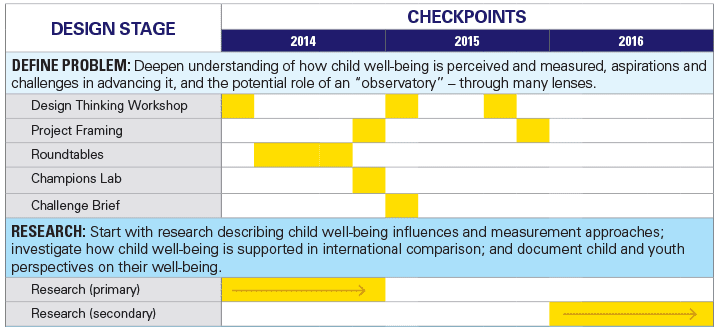
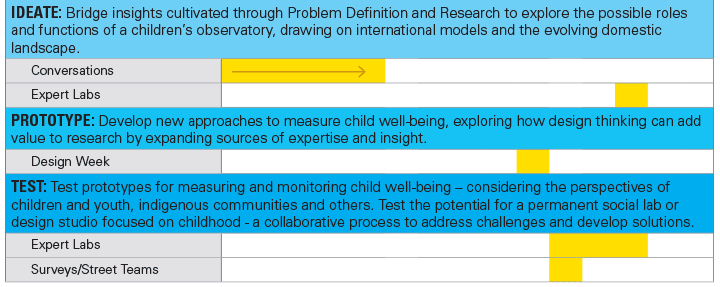
UNICEF Canada continues to ideate and test possible prototypes for a “children’s observatory” to support advances in child and youth well-being in Canada. A children’s observatory could foster innovative approaches to measure child well-being and influence social responses based on improved understanding of children’s lives, with the mission to elevate the well-being of children from a middle position in the UNICEF Index of Child Well-Being.
We are testing the potential for a “children’s observatory” to host a permanent design lab or studio dedicated to child well-being. Design Week in October 2015 convened more than 30 participants from across the country to help us explore this potential and we’ll continue to engage designers and other stakeholders to understand how we might support design collaboration with and for children.
Design Week also generated prototypes of innovative approaches to collecting data with and by children to inform understanding of their well-being. UNICEF Canada is currently feasibility testing “Wellbot” and “Youth Booth”, which have the potential to revolutionize the way children and young people are heard and to generate data that complements or services population surveys. Following feasibility testing with a wide range of informants, we’ll be able to determine if next version prototypes should be built for user testing.
YOUTH BOOTH: A portable object the size of a telephone booth in which older children/youth can record statements about issues asked about (i.e., survey questions) or provide open-ended statements; create video and other communication options; and generate new data to inform various audiences.
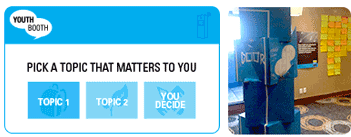
WELLBOT: A friendly, roving robot that collects data/information from children by asking them simple questions about their lives; reports this information back to a survey/analysis platform; and drives public discussion by travelling the country. Groups of children could take Wellbot to other communities and engage with them.
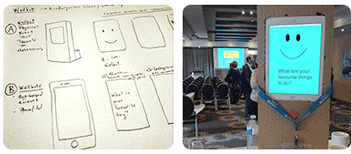
We’ll also test the “Well-being Cultural Media Office” prototype: A message placement team that might work strategically with mainstream television, film and other media to integrate issues of child well-being into the public narrative/awareness.
Our Research Agenda is proceeding with studies by the International Institute for Child Rights and Development, Ron Wray and Dr. Nazilla Khanlou, and the Students Commission of Canada, together with a multidisciplinary Research Advisory Group. Key research questions include:
We’ve interviewed dozens of informants in seven countries to inform our research – revealing fascinating insights about child well-being to extend beyond literature review. To listen to children and youth, we are drawing on years of consultations by organizations across Canada to identify important themes about their well-being and the implications for efforts to measure it. We’ve tested the use of storyboards in child and youth action research in Canada, New Zealand, Norway and Germany, like the one created below by Iri, 16 years old, of New Zealand
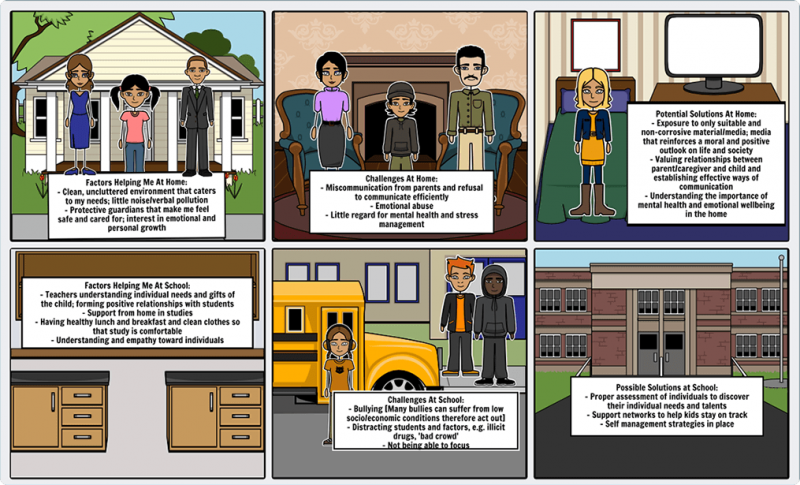
These recent developments in Canada and worldwide amplify the conversations at the intersection of child well-being, measurement and innovation:
UNICEF believes that consistent, credible data about children's situations are critical to the improvement of their lives and indispensable to realizing their equitable opportunities. Much of the progress on data for children over the past couple of decades has been spurred by the rapid expansion and innovation of international household survey programs, such as the UNICEF-supported Multiple Indicator Cluster Survey (MICS). Twenty years of building up MICS has strengthened the capacity of governments to collect, analyze, share and act on data about children – to improve investments, policies, services and ultimately children’s lives. The data we develop also provides evidence for civil society, including children themselves, to advocate and to hold their governments to account.
Despite significant advances in the quantity and quality of data and how it is analyzed, there are still critical gaps in our knowledge about children’s well-being, particularly children in greatest need – and in our ability to measure our success in reaching them. To give voice to these children, we need to collectively invest in improving data collection methods and systems.
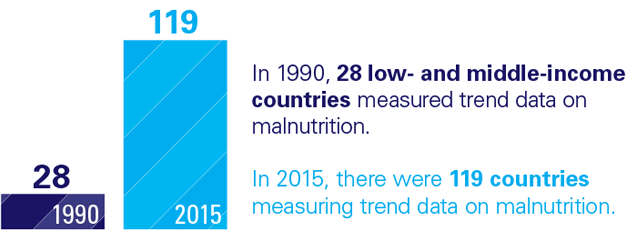
In case you missed it, here are some UNICEF publications released in 2015:
The third Child Well-Being Expert Consultation was convened by the OECD and UNICEF in November 2015 to discuss the state of the art in measuring and monitoring child well-being. The objective was to help the OECD put child well-being higher on the political agenda of member states. Participants agreed that we cannot improve the well-being of children without children's perspectives, and that a critical means of advancing children's rights and well-being is collecting data from and with children. Children are different than adults in what influences their well-being. For instance, indicators that measure “friendships” (belonging) and “choice” (agency) are predominantly important to children's sense of well-being. These indicators have been tested in two waves of the Children’s World’s survey, a new complement to international population surveys of children and youth. The latest Children’s Worlds survey data were released on 8 January 2016. UNICEF, the OECD and the European Commission presented current initiatives to measure and monitor child well-being and a thematic discussion explored the diversification of family forms and their implications for child well-being and policy responses.

In September 2015, the world community transitioned from the Millennium Development Goals (MDGs) to embrace the Sustainable Development Goals. Like the Millennium Development Goals that came before them, the new Global Goals for 2030 will rely on data to track progress. Due in part to the MDGs, the availability and depth of credible and reliable data about children’s lives in middle- and low-income countries has improved exponentially since 1990. The Global Goals are universal and even more ambitious. They integrate the three pillars of sustainable development – social progress (people), economic growth (prosperity) and environmental protection (planet) – in 17 goals and 169 targets. By March 2016, the global monitoring and implementation framework is set to be finalized based on consultations among UN agencies and 28 member states including Canada. These indicators will be used to assess progress toward the Global Goals across all countries. UNICEF’s priority is to ensure robust, child-focused indicators in the international monitoring framework and in any complementary frameworks developed at the national level. This effort includes ensuring age disaggregation as well as specific indicators relevant to children.
There are three targets of direct relevance to child poverty under Goal 1:
Target 1.1 aims to eradicate extreme poverty according to the World Bank definition, very much in line with the World Bank’s goal. While this is mostly relevant for low income countries, it remains a highly visible target.
Target 1.2 aims to “by 2030, reduce at least by half the proportion of men, women and children of all ages living in poverty in all its dimensions according to national definitions”. The target aims to tackle poverty in all its dimensions, beyond family income. While family income is a major determinant of child poverty and, in turn, child well-being, many high-income countries have developed additional measures of child poverty such as the deprivation index used by most European countries. This target presents Canada with the opportunity to refresh and adopt official national yardsticks of child poverty that can be internationally compared.
Target 1.3 aims to expand the coverage of social protection systems with a special focus on the poor and most vulnerable. A specific focus on children in income benefits can, if well-designed, lift more children out of poverty and prevent them from falling far below the poverty line. The goal of all levels of government should be to maximize resources for families with children.
UNICEF expects that the recognition of child poverty as a global and national priority will help improve the availability of data and promote action to address child poverty in all its dimensions.
Access these resources for the Global Goals:
New technologies are leading to an exponential increase in volume and types of data about people, creating unprecedented possibilities for informing and transforming society. Governments, companies, researchers and citizen groups are in a ferment of experimentation, innovation and adaptation to a world in which data are generated faster and more abundantly than ever before. This is the data revolution.
One estimate suggests that 90% of the data in the world has been created in the last two years. In any case, the volume and openness of traditional sources of data (e.g., household surveys) are increasing worldwide. But with new technologies, the amount, level of detail and speed of other types of data about people and the planet is without precedent. UNICEF is working to ensure that a world of faster, more networked and more comprehensive data works for and protects children.
Despite the data revolution, significant data and knowledge gaps remain about some of the greatest challenges we face, many people and groups still go uncounted, and important aspects of people’s lives are not measured. Potentially useful data go unused because they are not available at the level of detail needed or in ways that support understanding and decision-making. There is a risk if a breakdown in trust between the institutions that administer or have access to their data means that people do not feel confident giving consent to uses of their data for social good, such as to track patterns of disease or assess inequalities. Harm can result if data if poor quality data are used as a basis for decision-making. Children’s rights cut across many issues related to the data revolution and bring opportunities, risks and challenges. These rights include but are not limited to the rights to be counted, to an identity, to privacy and to ownership of personal data, to due process (for example when data is used as evidence in proceedings or in administrative decisions), to freedom of expression, to participation and consent, and to non-discrimination and equity.
It is true that not everything that can be measured matters, and not everything that matters can be measured, to paraphrase the aphorisms of others. But rightly or wrongly, to paraphrase another, what gets measured matters more. With the data revolution comes the opportunity to improve the data that is essential for decision-making, accountability and improving the well-being of children. Data doesn’t just have to be about or even for children, but there are new avenues to create data by and with children. The purpose should be to better understand children’s lives, which in turn enables individuals, public and private institutions and companies to make better decisions. New institutions, new actors, new ideas and new partnerships are needed – all have something to offer the data revolution.
In 2014, UN Secretary-General Ban Ki-moon asked the Independent Expert Advisory Group on data and the Global Goals to recommend how to make the data revolution work for the well-being of people, particularly the most disadvantaged. The report, A World That Counts: Mobilising the Data Revolution for Sustainable Development, calls for a UN-led effort. It’s clear from their work that while high-income countries such as Canada typically have more developed data landscapes, every nation needs to innovate to bring better data to the service of children – and to collaborate to avoid becoming a data island:
“Data are the lifeblood of decision-making and the raw material for accountability. Without high-quality data providing the right information about the right things at the right time; designing, monitoring and evaluating effective policies becomes almost impossible.”

In the next few months, we’ll move from feasibility testing to user testing the prototypes created in Design Week and continue to explore how and what an observatory might do, culminating in a strategic retreat.
Look for our research publications examining what we can learn about how the top-performing nations in UNICEF’s Index of Child Well-being achieve so much for their children – coming in Spring 2016. UNICEF will also release Report Card 13, going behind the national averages posted in the UNICEF Index to examine inequality in child health, education, material resources and life satisfaction – and the extent to which high-income countries allow some children to fall below the average.

UNICEF is very interested in how to address important challenges for children creatively and effectively. Overlap Associates introduced us to design thinking as an approach to problem solving. It’s proving to have incredible value to us in exploring the potential for a children’s observatory, and we thought it could be helpful for you too. We asked Overlap to contribute a design tip or tool for each update. We hope you find the third tip in this series helps leverage collaboration – stay tuned for the next tip!
Without hurting anyone’s feelings, let me state two regrettable but undeniable facts.
When you want to accomplish something that’s bigger than you are, you’ll need a team. Division of labour isn’t the only reason to collaborate. It’s not even the best reason to collaborate. John Clees, of Monty Python fame, said, “When you collaborate with someone else on something creative, you get to places that you would never get to on your own.” And design thinking is a way to get there.
Done right, design thinking is how to intentionally “play well with others.” Lots of people idealize collaboration. Design thinking operationalizes it. It makes collaboration practical.
If I could share just one principle for powerful collaboration, it would be this.
Start solo.
It’s woven into most design thinking activities. Before the group shares, combines or critiques anything, give everyone some “me time” to gather their ideas and responses, in writing. For example:
Collaboration is more than getting along despite our differences. It’s about leveraging those differences. Design thinking is full of playful, pragmatic methods to solicit everyone’s input uncritically, balance contributions from introverts and extroverts, combine and extend the ideas of the group, reach consensus on priorities, encourage constructive feedback, and collect the information you need to make quality decisions. It’s how to make the most of many minds.
Linda Carson
Overlap Associates
The gov.uk site has become an unexpected star online for its commitment to usability and its frankness about its collaboration processes. Read about how they use walls as “vertical campfires” to support collaboration and to keep user needs top of mind. Their mantra? “User research is a team sport.” Steal this idea!
Your single best resource is Gamestorming, an invaluable playbook from Dave Gray, Sunni Brown & James Macanufo that gathers the most effective collaborative activities for guiding conversations, extracting insights and co-creating solutions.

E-mail us at policy@unicef.ca with questions and suggestions – we would love to hear from you.
You are receiving this update because you participated in our activities. Please let us know if you don’t wish to receive future updates (policy@unicef.ca).